Dimitris Bertsimas
Adaptive Forests For Classification
Oct 27, 2025Abstract:Random Forests (RF) and Extreme Gradient Boosting (XGBoost) are two of the most widely used and highly performing classification and regression models. They aggregate equally weighted CART trees, generated randomly in RF or sequentially in XGBoost. In this paper, we propose Adaptive Forests (AF), a novel approach that adaptively selects the weights of the underlying CART models. AF combines (a) the Optimal Predictive-Policy Trees (OP2T) framework to prescribe tailored, input-dependent unequal weights to trees and (b) Mixed Integer Optimization (MIO) to refine weight candidates dynamically, enhancing overall performance. We demonstrate that AF consistently outperforms RF, XGBoost, and other weighted RF in binary and multi-class classification problems over 20+ real-world datasets.
Prescribe-then-Select: Adaptive Policy Selection for Contextual Stochastic Optimization
Sep 09, 2025Abstract:We address the problem of policy selection in contextual stochastic optimization (CSO), where covariates are available as contextual information and decisions must satisfy hard feasibility constraints. In many CSO settings, multiple candidate policies--arising from different modeling paradigms--exhibit heterogeneous performance across the covariate space, with no single policy uniformly dominating. We propose Prescribe-then-Select (PS), a modular framework that first constructs a library of feasible candidate policies and then learns a meta-policy to select the best policy for the observed covariates. We implement the meta-policy using ensembles of Optimal Policy Trees trained via cross-validation on the training set, making policy choice entirely data-driven. Across two benchmark CSO problems--single-stage newsvendor and two-stage shipment planning--PS consistently outperforms the best single policy in heterogeneous regimes of the covariate space and converges to the dominant policy when such heterogeneity is absent. All the code to reproduce the results can be found at https://anonymous.4open.science/r/Prescribe-then-Select-TMLR.
From Data to Uncertainty Sets: a Machine Learning Approach
Mar 04, 2025



Abstract:Existing approaches of prescriptive analytics -- where inputs of an optimization model can be predicted by leveraging covariates in a machine learning model -- often attempt to optimize the mean value of an uncertain objective. However, when applied to uncertain constraints, these methods rarely work because satisfying a crucial constraint in expectation may result in a high probability of violation. To remedy this, we leverage robust optimization to protect a constraint against the uncertainty of a machine learning model's output. To do so, we design an uncertainty set based on the model's loss function. Intuitively, this approach attempts to minimize the uncertainty around a prediction. Extending guarantees from the robust optimization literature, we derive strong guarantees on the probability of violation. On synthetic computational experiments, our method requires uncertainty sets with radii up to one order of magnitude smaller than those of other approaches.
Optimal Control of Fluid Restless Multi-armed Bandits: A Machine Learning Approach
Feb 06, 2025



Abstract:We propose a machine learning approach to the optimal control of fluid restless multi-armed bandits (FRMABs) with state equations that are either affine or quadratic in the state variables. By deriving fundamental properties of FRMAB problems, we design an efficient machine learning based algorithm. Using this algorithm, we solve multiple instances with varying initial states to generate a comprehensive training set. We then learn a state feedback policy using Optimal Classification Trees with hyperplane splits (OCT-H). We test our approach on machine maintenance, epidemic control and fisheries control problems. Our method yields high-quality state feedback policies and achieves a speed-up of up to 26 million times compared to a direct numerical algorithm for fluid problems.
Multimodal Prescriptive Deep Learning
Jan 24, 2025Abstract:We introduce a multimodal deep learning framework, Prescriptive Neural Networks (PNNs), that combines ideas from optimization and machine learning, and is, to the best of our knowledge, the first prescriptive method to handle multimodal data. The PNN is a feedforward neural network trained on embeddings to output an outcome-optimizing prescription. In two real-world multimodal datasets, we demonstrate that PNNs prescribe treatments that are able to significantly improve estimated outcomes in transcatheter aortic valve replacement (TAVR) procedures by reducing estimated postoperative complication rates by 32% and in liver trauma injuries by reducing estimated mortality rates by over 40%. In four real-world, unimodal tabular datasets, we demonstrate that PNNs outperform or perform comparably to other well-known, state-of-the-art prescriptive models; importantly, on tabular datasets, we also recover interpretability through knowledge distillation, fitting interpretable Optimal Classification Tree models onto the PNN prescriptions as classification targets, which is critical for many real-world applications. Finally, we demonstrate that our multimodal PNN models achieve stability across randomized data splits comparable to other prescriptive methods and produce realistic prescriptions across the different datasets.
Deep Trees for (Un)structured Data: Tractability, Performance, and Interpretability
Oct 28, 2024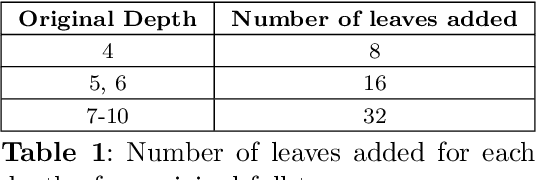
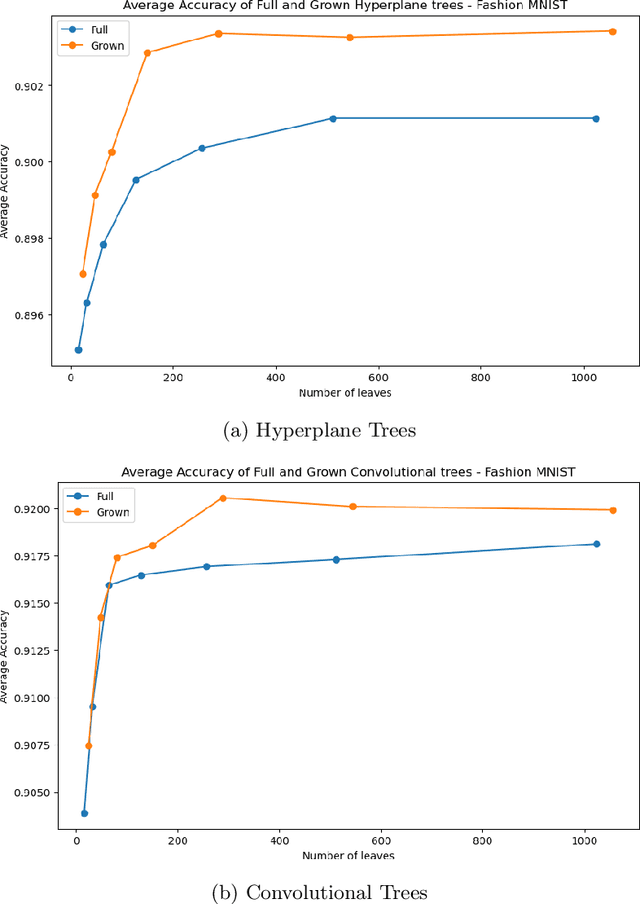
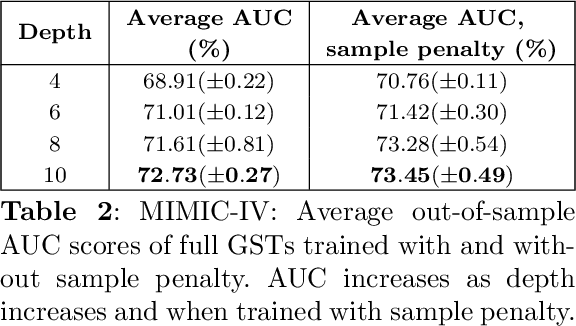
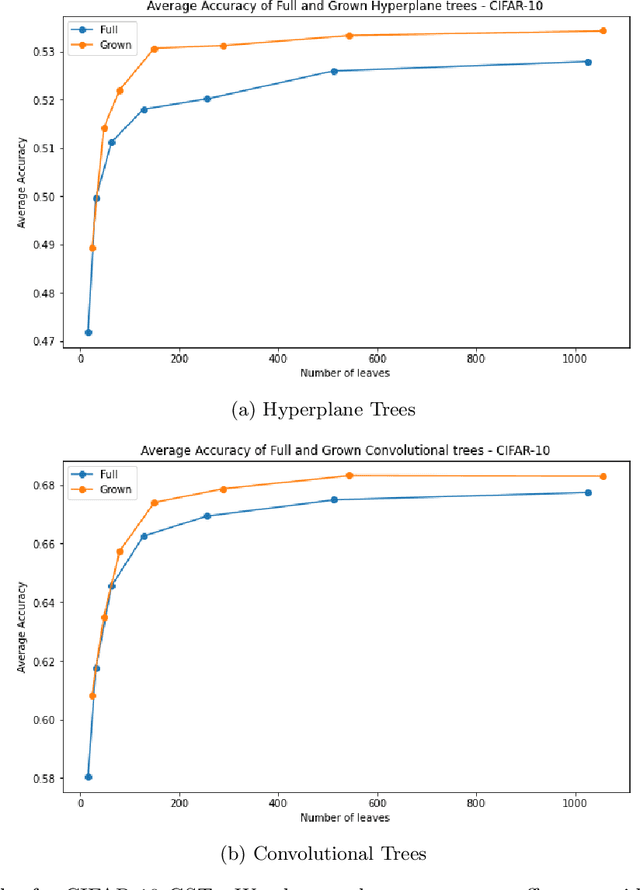
Abstract:Decision Trees have remained a popular machine learning method for tabular datasets, mainly due to their interpretability. However, they lack the expressiveness needed to handle highly nonlinear or unstructured datasets. Motivated by recent advances in tree-based machine learning (ML) techniques and first-order optimization methods, we introduce Generalized Soft Trees (GSTs), which extend soft decision trees (STs) and are capable of processing images directly. We demonstrate their advantages with respect to tractability, performance, and interpretability. We develop a tractable approach to growing GSTs, given by the DeepTree algorithm, which, in addition to new regularization terms, produces high-quality models with far fewer nodes and greater interpretability than traditional soft trees. We test the performance of our GSTs on benchmark tabular and image datasets, including MIMIC-IV, MNIST, Fashion MNIST, CIFAR-10 and Celeb-A. We show that our approach outperforms other popular tree methods (CART, Random Forests, XGBoost) in almost all of the datasets, with Convolutional Trees having a significant edge in the hardest CIFAR-10 and Fashion MNIST datasets. Finally, we explore the interpretability of our GSTs and find that even the most complex GSTs are considerably more interpretable than deep neural networks. Overall, our approach of Generalized Soft Trees provides a tractable method that is high-performing on (un)structured datasets and preserves interpretability more than traditional deep learning methods.
Binary Classification: Is Boosting stronger than Bagging?
Oct 24, 2024



Abstract:Random Forests have been one of the most popular bagging methods in the past few decades, especially due to their success at handling tabular datasets. They have been extensively studied and compared to boosting models, like XGBoost, which are generally considered more performant. Random Forests adopt several simplistic assumptions, such that all samples and all trees that form the forest are equally important for building the final model. We introduce Enhanced Random Forests, an extension of vanilla Random Forests with extra functionalities and adaptive sample and model weighting. We develop an iterative algorithm for adapting the training sample weights, by favoring the hardest examples, and an approach for finding personalized tree weighting schemes for each new sample. Our method significantly improves upon regular Random Forests across 15 different binary classification datasets and considerably outperforms other tree methods, including XGBoost, when run with default hyperparameters, which indicates the robustness of our approach across datasets, without the need for extensive hyperparameter tuning. Our tree-weighting methodology results in enhanced or comparable performance to the uniformly weighted ensemble, and is, more importantly, leveraged to define importance scores for trees based on their contributions to classifying each new sample. This enables us to only focus on a small number of trees as the main models that define the outcome of a new sample and, thus, to partially recover interpretability, which is critically missing from both bagging and boosting methods. In binary classification problems, the proposed extensions and the corresponding results suggest the equivalence of bagging and boosting methods in performance, and the edge of bagging in interpretability by leveraging a few learners of the ensemble, which is not an option in the less explainable boosting methods.
Predictive Low Rank Matrix Learning under Partial Observations: Mixed-Projection ADMM
Jul 18, 2024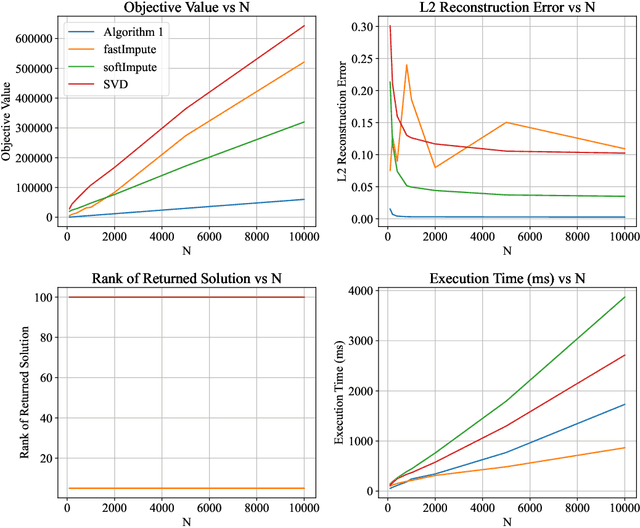
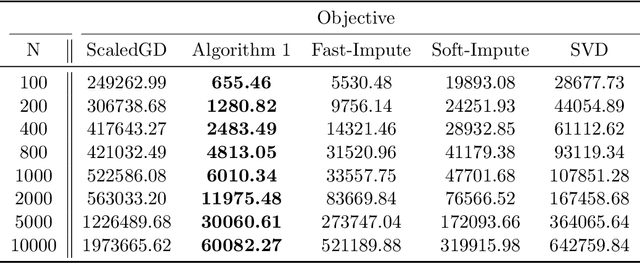
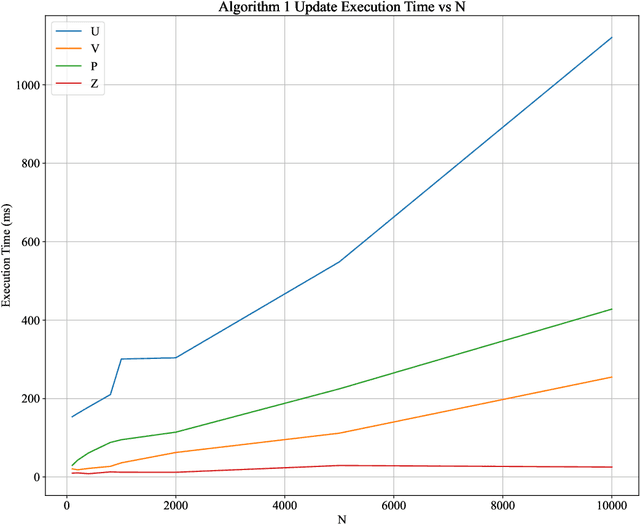
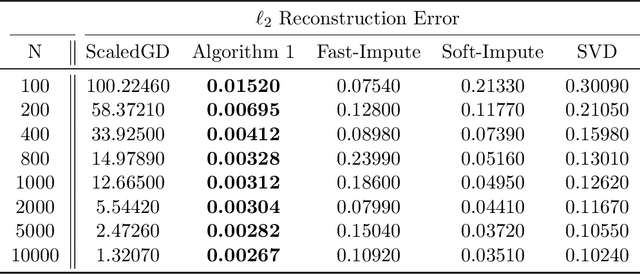
Abstract:We study the problem of learning a partially observed matrix under the low rank assumption in the presence of fully observed side information that depends linearly on the true underlying matrix. This problem consists of an important generalization of the Matrix Completion problem, a central problem in Statistics, Operations Research and Machine Learning, that arises in applications such as recommendation systems, signal processing, system identification and image denoising. We formalize this problem as an optimization problem with an objective that balances the strength of the fit of the reconstruction to the observed entries with the ability of the reconstruction to be predictive of the side information. We derive a mixed-projection reformulation of the resulting optimization problem and present a strong semidefinite cone relaxation. We design an efficient, scalable alternating direction method of multipliers algorithm that produces high quality feasible solutions to the problem of interest. Our numerical results demonstrate that in the small rank regime ($k \leq 15$), our algorithm outputs solutions that achieve on average $79\%$ lower objective value and $90.1\%$ lower $\ell_2$ reconstruction error than the solutions returned by the experiment-wise best performing benchmark method. The runtime of our algorithm is competitive with and often superior to that of the benchmark methods. Our algorithm is able to solve problems with $n = 10000$ rows and $m = 10000$ columns in less than a minute.
Policy Trees for Prediction: Interpretable and Adaptive Model Selection for Machine Learning
May 30, 2024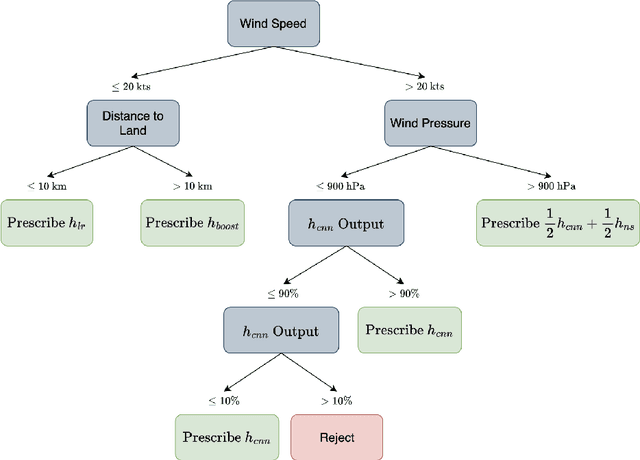

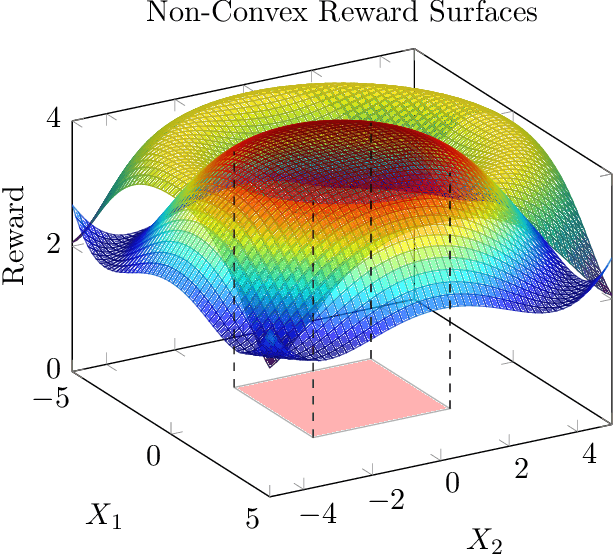
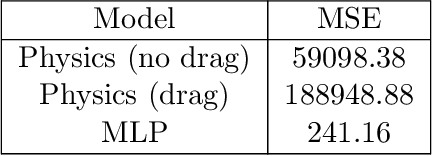
Abstract:As a multitude of capable machine learning (ML) models become widely available in forms such as open-source software and public APIs, central questions remain regarding their use in real-world applications, especially in high-stakes decision-making. Is there always one best model that should be used? When are the models likely to be error-prone? Should a black-box or interpretable model be used? In this work, we develop a prescriptive methodology to address these key questions, introducing a tree-based approach, Optimal Predictive-Policy Trees (OP2T), that yields interpretable policies for adaptively selecting a predictive model or ensemble, along with a parameterized option to reject making a prediction. We base our methods on learning globally optimized prescriptive trees. Our approach enables interpretable and adaptive model selection and rejection while only assuming access to model outputs. By learning policies over different feature spaces, including the model outputs, our approach works with both structured and unstructured datasets. We evaluate our approach on real-world datasets, including regression and classification tasks with both structured and unstructured data. We demonstrate that our approach provides both strong performance against baseline methods while yielding insights that help answer critical questions about which models to use, and when.
Catastrophe Insurance: An Adaptive Robust Optimization Approach
May 11, 2024



Abstract:The escalating frequency and severity of natural disasters, exacerbated by climate change, underscore the critical role of insurance in facilitating recovery and promoting investments in risk reduction. This work introduces a novel Adaptive Robust Optimization (ARO) framework tailored for the calculation of catastrophe insurance premiums, with a case study applied to the United States National Flood Insurance Program (NFIP). To the best of our knowledge, it is the first time an ARO approach has been applied to for disaster insurance pricing. Our methodology is designed to protect against both historical and emerging risks, the latter predicted by machine learning models, thus directly incorporating amplified risks induced by climate change. Using the US flood insurance data as a case study, optimization models demonstrate effectiveness in covering losses and produce surpluses, with a smooth balance transition through parameter fine-tuning. Among tested optimization models, results show ARO models with conservative parameter values achieving low number of insolvent states with the least insurance premium charged. Overall, optimization frameworks offer versatility and generalizability, making it adaptable to a variety of natural disaster scenarios, such as wildfires, droughts, etc. This work not only advances the field of insurance premium modeling but also serves as a vital tool for policymakers and stakeholders in building resilience to the growing risks of natural catastrophes.
 Add to Chrome
Add to Chrome Add to Firefox
Add to Firefox Add to Edge
Add to Edge